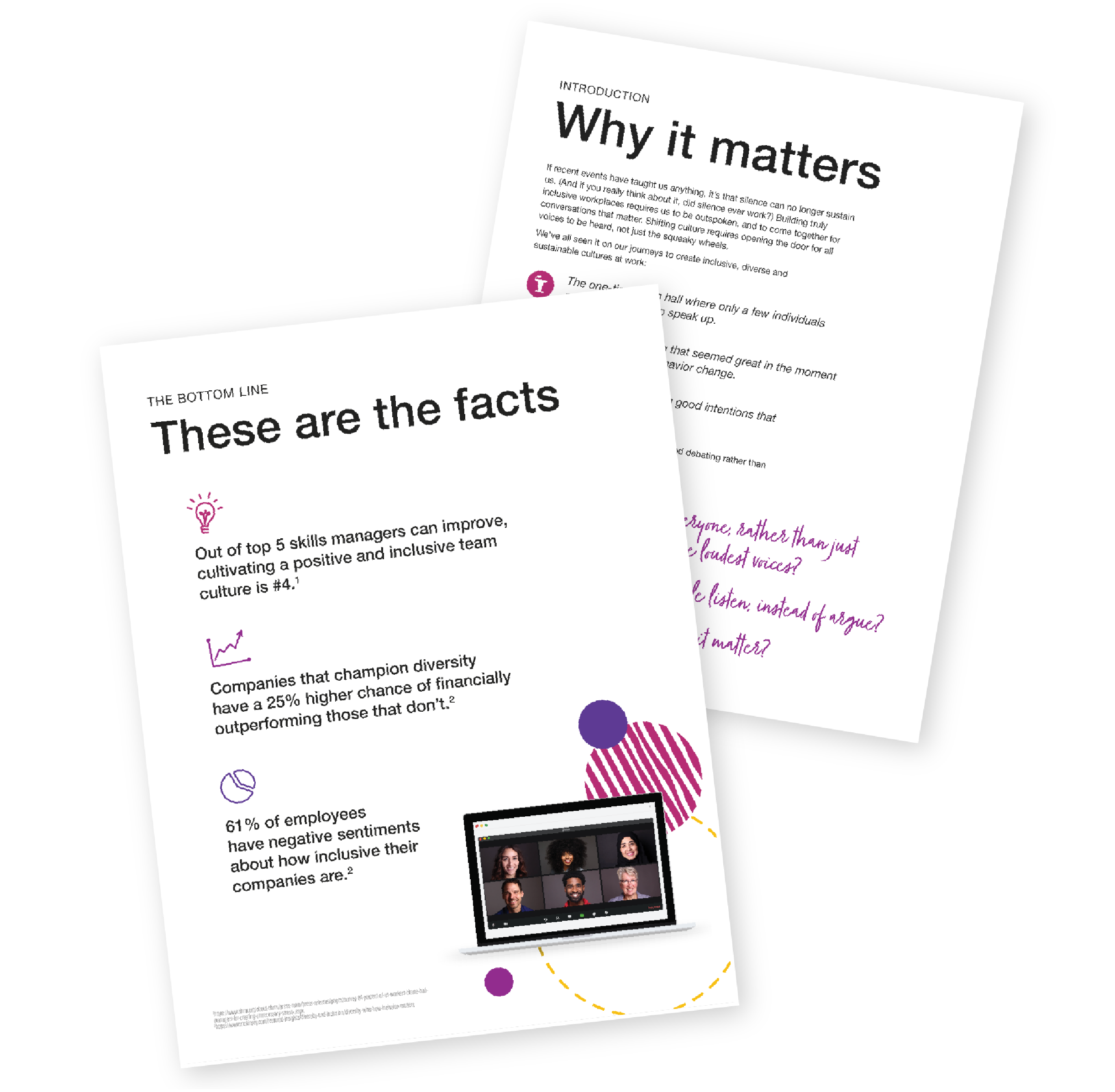Working in silos?
In today's workplaces, we're surrounded by communication tools, from emails to Slack to virtual meeting rooms. But despite this abundance, a common problem persists: silos.
Silos are those unseen barriers that hinder communication and collaboration, casting a shadow over productivity and engagement. They slow progress, create discord, and block the path to shared goals.
For managers and leaders, breaking down silos isn't just a goal; it's a must. By dismantling these barriers, organizations can create a culture of belonging and innovation, where diverse teams can come together and think creatively.
When Microsoft wanted to encourage social interaction and collaboration, while showing off their software’s capabilities, they built a communal workspace for staff and visitors alike, along with teamwork benches, individual workspaces, meeting rooms, and two auditoriums. They also added a coffee shop, indoor and outdoor dining areas, lounges, and sleep pods.
Soon, employees from different departments began bumping into each other during breaks, sparking conversations, sharing ideas, and building bonds. And Microsoft saw a 25% productivity gain.
While workplaces vary, the importance of communication and collaboration remains constant. Studies show that businesses that prioritize communication are up to 25% more productive. And a whopping 86% of executives believe that poor collaboration and communication lead to business failures.
Communication and collaboration are key to organizational success. As we work to break down silos and foster connectivity, every interaction brings us closer to unlocking our teams' full potential and achieving greatness together.
What are silos?
Silos, much like the ones you see on farms, represent divisions within an organization that separate individuals or groups based on roles, departments, or hierarchy. These divisions inhibit the flow of information, hinder collaboration, and foster a mindset of "us versus them."
3 Types of Silos
Organizational Silos
Many companies are structured with multiple departments and sub-departments. However, when these departments become hierarchical or overly specialized, they can create organizational silos that impede the flow of information.
The problem arises when departments operate too independently, focusing solely on their own goals rather than the broader objectives of the company. In some cases, this independence can lead to conflicts over resources or deliberate disruptions to other departments' workflows.
We've seen how Google's highly departmentalized structure led to silos. Each division, from Search to Android to YouTube, operated with significant autonomy, resulting in limited cross-team collaboration. This autonomy sometimes led to conflicts over resources or conflicting priorities between departments.
By contrast, Georgia Public Broadcasting's use of Inclusivv's Inclusion and Belonging Journey Membership fosters a culture of inclusion and collaboration, breaking down silos and encouraging employees from engineers to journalists to come together and share insights, ideas, and experiences. This approach not only strengthens internal relationships but also enhances the organization's overall effectiveness and adaptability in serving its audience.
Information Silos
Information silos occur when departments fail to properly record, share, and integrate new information. Instead of promoting open access to data and ideas, departments hoard information or have a lack of transparency around data access.
Walmart has faced challenges with information silos due to its multinational size and diverse operations. With different departments using various communication tools and platforms, such as email, internal portals, and proprietary software, there was a lack of cohesion in information sharing. This fragmentation led to inefficiencies in decision-making, customer service, and inventory management.
Another form of information silo occurs when individual teams lack adequate channels to share information. For example, at IBM, despite its emphasis on collaboration, there were instances where teams struggled to disseminate important decisions or updates to relevant stakeholders due to the absence of a unified communication platform.
Silo Mentality
Silo mentality manifests at the individual level, where employees, managers, or executives prioritize personal goals over collective success. Individuals with a silo mentality may withhold information or ideas that do not align with their own interests or objectives.
At Enron, the energy company embroiled in one of the largest corporate scandals in history, a silo mentality among employees and executives contributed to its downfall. Rather than fostering a culture of transparency and collaboration, Enron's corporate culture prioritized individual success and competition. Employees were incentivized to achieve personal goals at the expense of ethical behavior and company-wide objectives. This siloed mindset fostered a lack of accountability and communication, ultimately leading to Enron's collapse and bankruptcy.
"With silo mentality organizations lose their collaborative advantage as they are being over managed and under led." — Pearl Zhu
How are silos formed?
Here are some common causes of silos:
Communication Hierarchies
In organizations where information flows from top to bottom, the potential for misunderstandings and errors increases. Mistrust in leadership, toxic personalities, and office politics can impede the timely dissemination of information, confining it within certain circles.
Ego-Driven Management
When managers let personal disagreements or competitive attitudes overshadow their responsibilities, they may fail to communicate effectively with their teams or with other supervisors.
This failure to communicate not only obstructs the flow of information but also fosters a toxic work environment. Team members may perceive the power struggles among leaders and adopt a similar attitude, further exacerbating the problem.
Physical Separation:
Geographical distance or remote work arrangements can contribute to silo formation by limiting face-to-face interaction and spontaneous collaboration.
Overspecialization:
While leveraging individual strengths is beneficial, departments overly focused on their own objectives may overlook the broader needs of the organization. This tunnel vision prevents them from seeing the bigger picture and hampers opportunities for collective growth.
Rapid Growth:
In periods of rapid growth, leaders may become overwhelmed, neglecting communication at lower levels of the organization. New hires, inundated with information or feeling disconnected from the core operations, may struggle to integrate into the company culture.
This lack of communication further exacerbates the siloing effect, as vital information fails to reach all members of the organization in a timely manner.
What happens if you don't break down silos?
When silos go unchecked, organizations face serious consequences due to communication barriers. Here are three outcomes of siloed environments:
Stagnation
In siloed departments, employees get used to their isolated routines. They resist changes from management, making it hard for the organization to adapt and innovate.
Inconsistent Customer Experience
Inconsistencies in communication stemming from siloed operations can result in a poor customer experience. When employees provide conflicting information or handle conflicts differently, it decreases customer trust in the company.
Rebuilding this trust becomes challenging, potentially impacting customer retention and brand reputation. Worldwide, bad customer experience costs companies $3.7 trillion annually, and 76% of consumers would stop doing business with a company after just one bad customer experience.
Poor company culture
Communication plays an important role in building a strong company culture — an organization's shared attitudes, behaviors, values, and work norms.
Engaged employees are not only 17% more productive but are also more likely to remain with a company where they feel valued. By failing to address silos and foster open communication, organizations risk alienating employees and potentially losing them.
4 ways to break down silos at work
1. Reach out to and align with other departments
Getting acquainted with a different department’s goals and daily practices, close enough to understand how they intersect with the ideas and practices of your own team, is one way of flattening silos.
Leaders should define transparent guidelines and expectations to facilitate this process. This could mean having regular meetings between departments, small group discussions, or working on projects together. It's important to find things that everyone has in common and show how departments can work together to achieve shared goals.
2. Make it a group effort
Creating a unified leadership team is key to fostering regular communication centered on shared goals. However, it's important to acknowledge that breaking down barriers and building belonging is an ongoing journey that involves everyone, not just leaders. It's challenging to compel two separate departments to engage with each other, especially when their work seems unrelated.
Instead, the focus should be on encouraging individual team members to step outside their comfort zones and explore what other teams are doing. To truly dissolve silos, there needs to be a concerted effort to understand how each team contributes to the organization's objectives. Cultivating a sense of curiosity among your team members is crucial in this process.
Inclusivv provides a platform to bring your group together, allowing for peer-to-peer dialogue and the exchange of ideas among team members from diverse backgrounds and departments. Whether online or in person works better for your organization, Inclusivv conversations have resulted in increased connection, belonging, empathy and understanding amongst team members.
3. Prioritize rebuilding trust
If your organization's silos stem from personal conflicts and lingering animosity, breaking them down requires rebuilding trust. Without trust, teams and leaders will struggle to communicate openly and overcome barriers between their departments.
Your primary focus in overcoming the silo mentality should be nurturing a healthy company culture. This includes fostering a psychologically safe workplace where collaboration, openness, and transparency are encouraged.
Reestablishing trust, particularly among those with strained relationships, involves more than just superficial gestures. It requires honesty and sincerity. You can introduce a platform like Inclusivv that creates a culture of trust, inclusion and respect through courageous conversations.
4. Emphasize company-wide upskilling
59% of organizations prioritize up-skilling and re-skilling as key objectives for Learning and Development (L&D). Skill enhancement not only empowers individuals to advance in their careers but also fosters collaboration across teams, creating clear pathways to diverse roles within the organization. Implementing a transparent career mapping framework helps team members explore opportunities beyond their respective silos.
Dawn Wood, an HR Manager at Woodyatt Curtains, advocates for a culture of continuous learning to enhance communication across the company. In her opinion:
“One of the best ways to improve communication across a company is to foster a sharing environment by consistent, company-wide up-skilling. Whether that's training for something as simple as Microsoft Teams and Zoom for a hybrid workforce, right down to introductory training for other departments to gain a deeper understanding regarding the work of their colleagues. An open, communicative environment flourishes in a workplace that is continually pushing the boundaries of learning (across all departments, not just keeping the learning department-specific.)"
Build bridges, not walls with Inclusivv
At Inclusivv, we make it easy for teams and employees to stay connected, which prevents silos from forming in the first place. But even better, we make it meaningful, too!
As a special offer, we invite you to be a free guest at our upcoming Inclusive Leadership Journey conversation this month. Join us to see how we can help you build a more connected and inclusive workplace.



%20(dragged).png?width=770&height=578&name=Membership%20Calendars%20(NEW)%20(dragged).png)
.png?width=960&height=540&name=_Inclusivv%20Capabilities%20Deck%20-%20April%202023%20(8).png)
